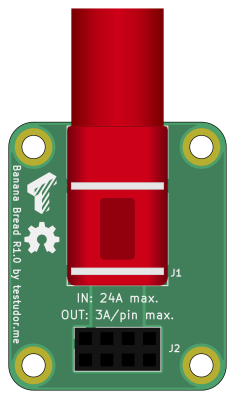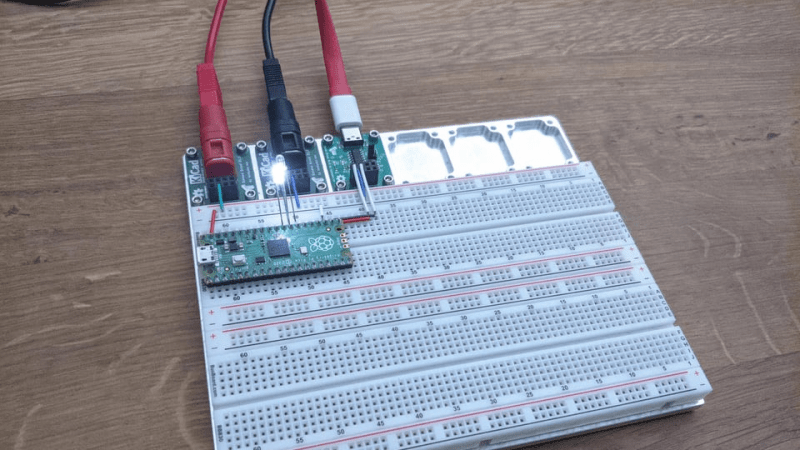Self-described passionate maker in the electronics and 3D printing world, [Jakob], aka [testudor], was getting frustrated trying to connect banana plugs to solderless breadboards. Project Banana Bread was born — small banana jack adaptors and a companion tray with pockets to hold up to six modules.

The base in the photo is made from 5083 aluminum, machined on a homemade CNC router. But design files for a yet-to-be-tested 3D printer version are available as well. As can happen, he strayed from the original goal of solving the banana jack issue, and also cranked out a USB-serial port and a blank template module for any custom interfaces folks may want to implement.
If it is only power connections you are interested in, we covered the Open Power project back in 2019. And also don’t forget the mother of all breadboards, this 1960s behemoth we wrote about last year. What kinds of breadboard interface modules do you find most useful? Let us know in the comments below.
















Love the quality of both the banana plug adapter board as well as the machined aluminium base (repo: https://github.com/testudor/modular-breadboard-base ; @Chris Lott/editors: I think this would have been the repo you wanted to link to in the article?).
Since everyone I know has suffered from bad connection reliability on cheap breadboard, hope the commercial breadboard on top comes close to the quality!
Thanks! I used a pair of BusBoard 830s, which are the best ones you can buy (at least according to breadboard wizard Ben Eater). I can also recommend the E-Call EIC-102, which I’ve used and abused for close to a decade without issues.
Breadboard: Thanks for the reference, by the way :) At 10€ incl. USt., that’s not even an expensive breaboard. Next mouser order will include one!
I once was considering going the following route:
– PCB with ZIF DIP socket on it (DIP-20 or longer)
– Ground plane below whole board, bottom side
– each pin of ZIF socket broken out to a self-clamping PCB terminal, like https://www.tme.eu/de/en/details/tb-2.5-pd-4p_gy/pcb-terminal-blocks/ninigi/ac141r-04p-2-54-gray/
– middle of top side: power rail
– next to each pin a SMD 0805 capacitor footprint, one side connected to pin, other to GND
– next to each pin also, a 3-pos jumper for tying to power or ground
Thing becomes a bit dense, because you need to get one 0805 and one 3× 2.54mm jumper between ZIF socket contact and PCB terminal contact, but if you stagger the positions, it’s pretty trivial to route.
The trouble with connectors is, they tend to be expensive.
Point in case: the Schützinger SWEB 8094 costs €4.85 in singles from my usual supplier. Goes down to €4.01 in volume, but that’s not cheap if you want to throw them around your projects.
Often the connectors and jacks end up costing ridiculous amounts, more than the project itself.
Oh, and that is before adding VAT as well.
Yeah, sadly they are quite pricey… The ones I used are around 4€ a piece after taxes and similar alternatives are even more expensive. Perhaps I will do a ‘budget’ version without the safety sleeve, those are way cheaper.
Banana jacks and connectors tend to be expensive because the main target is education and development. It’s either getting paid by public money, or they will be put into specialized products that cost a lot anyways. It’s not something you put in cheap commodity gadgets.
If you want to go for budget, use spade connectors.
You can use brass tube with 4mm ID soldered to a PC board as a cheap socket.
I bought the kits from https://www.tindie.com/products/arduinopraxis/breadboard-power-adapter-kit/ to be able to breadboard the Ben Eater kids powered by a bench supply (no fiddling with usb adapters)
Can we have a banana for scale?
🍌
Nice!
One more use case for me to obtain/build a CNC
Well, generally you connect the other end of the cable to the breadboard (which is generally an alligator clip), or you even remove the banana plug and use the wire itself.
Neat project for sure.
Could have done it with a 555 erm… I mean a piece of plywood and standoffs!
The potential for sparks and smoke will be smaller though…
I was thinking non-conductive might be better for reducing the potential for accidental shorts. But I suppose for RF projects that could be a ground plane…
If I was planning a production version, I’d probably make it from Delrin with some threaded inserts. This particular one is just for me and I trust myself enough to not let live wires touch the base.
why specifically Delrin? do you need the self lubrication and high dimensional stability?
I’d gather it would work even if it was a 3d printed PLA piece, especially if you include the brass inset nuts you mentioned, or at least used captive nuts or slots to add nuts to. I think it would make more sense to add a sliding piece that grabs the modules in such a way that you wouldn’t need to use screws and a screwdriver, but that’s up to you.
A simpler to use design (imo) would be to make channels so you can slide the boards from the side, and maybe make a hole on the PCB where a springy part locks into the board. release is as simple as lowering the springy bit. No tools needed.
I love the concept though. I can imagine an USB-C PD module that has a small pot that changes the voltage negotiation. You could do a pretty good variable voltage supply. Or also a constant current source module, for LED driving…
Delrin is popular for this sort of thing as it’s very easy to machine, that’s why it’s one of my prime candidates. I guess other plastics are fine too as long as they fit my needs.
I’ll always make sure that my design can be 3D printed as well, however I still prefer machining in this case as it’s just the better process if I ever want to sell this thing on tindie for example. 3D printing will take multiple hours, machining of some off-the-shelf plate stock just a few minutes.
I’m planning on a modifying the base slightly, so each module requires only two screws with the other two replaced by dowel pins. I thought about using some sort of latching clip before, but those tend to break and aren’t easy to manufacture either. I think the two screw solution is okay as people (probably) won’t be swapping modules constantly.
There’s an issue on GitHub for USB-C PD, but I’ve only done some basic research so far.
Thanks for the suggestions!
I made a very versatile power distribution board for the Heathkit ET-3300. https://www.galacticstudios.org/et-3300/
Pretty cool. This thing is just screaming for an RJ45 variant. I want to be able to test my bread board stuff from the other side of the… room… house… property… county?